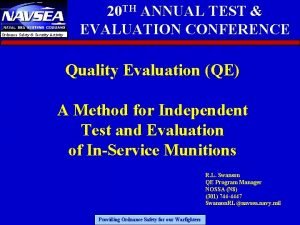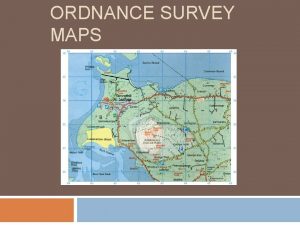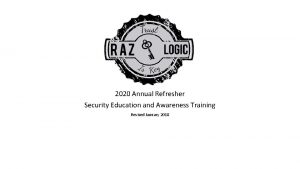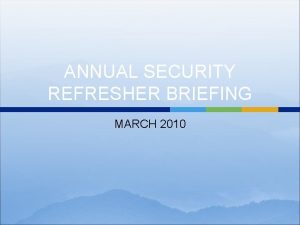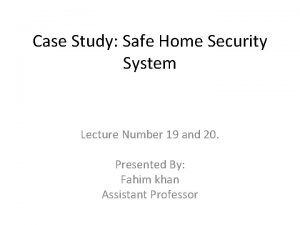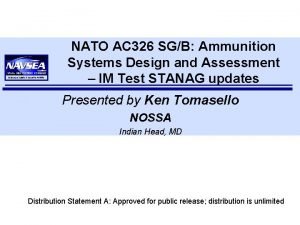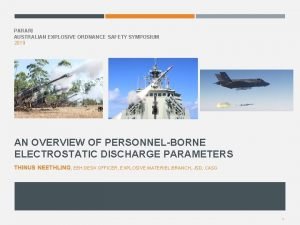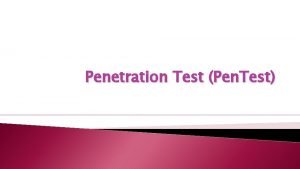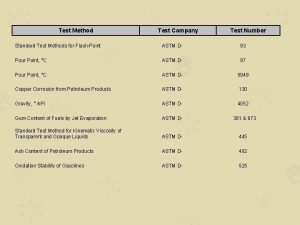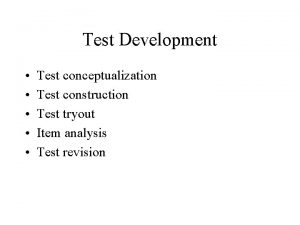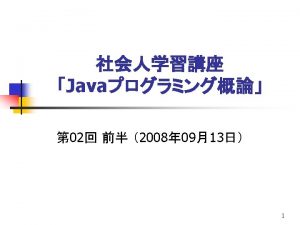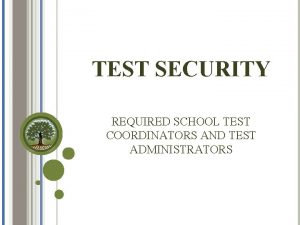Ordnance Safety Security Activity 20 TH ANNUAL TEST

















- Slides: 17

Ordnance Safety & Security Activity 20 TH ANNUAL TEST & EVALUATION CONFERENCE Quality Evaluation (QE) A Method for Independent Test and Evaluation of In-Service Munitions R. L. Swanson QE Program Manager NOSSA (N 8) (301) 744 -4447 Swanson. RL@navsea. navy. mil Providing Ordnance Safety for our Warfighters

Ordnance Safety & Security Activity NAVAL ORDNANCE SAFETY & SECURITY ACTIVITY • NOSSA: The Department of the Navy Technical Agent and Program Manager for Explosives Safety – Responsible for Weapons & Ordnance Explosive Safety Programs (ESP) and Related Environmental Matters – Program Management/Execution of Do. N/CNO Explosives Safety Programs (WSESRB, OS, OE, IM, & QE) • Overarching Goal: Enable/Optimize Do. N/National Combat Capability With Minimum Risk & Maximum Fleet Confidence Providing Ordnance Safety for our Warfighters 2

NOSSA CORE RATIONALE Ordnance Safety & Security Activity Explosives Safety Survivability Insensitive Munitions Quality Evaluation Providing Ordnance Safety for our Warfighters 3

Ordnance Safety & Security Activity QUALITY EVALUATION (QE) • Independent Test, Evaluation, and Analysis of Inservice Weapons & Ordnance for Changes that Impact: Safety, Reliability, and Performance • Determination and Prediction of Safe & Reliable Service, Usage, or Storage Lives for the Fleet and for the Design and Acquisition Communities • QE Program’s Goal: Prevent the Fleet From Being the Point of Detection of Failures Providing Ordnance Safety for our Warfighters 4

Ordnance Safety & Security Activity CONFERENCE THEME RELATIONSHIP “Defense Operational Test & Evaluation: Twenty Years and Counting: Doing OT&E Better After 20 Years of Practice” Navy Weapons and Ordnance Quality Evaluation Program is 60 Years Old and Improving Providing Ordnance Safety for our Warfighters 5

QE ORIGINAL MANDATE Ordnance Safety & Security Activity • BUORD ORDER NO. 23 -44 (6 July 1944): “Adequate inspections and tests shall be made of components and complete assemblies of all types of munitions throughout the stages of design and development, production, assembly, storage both afloat and ashore, and subsequent to any modification or overhaul; in order to insure the supply of satisfactory munitions to using activities as well as the continued serviceability and optimum performance of such munitions. ” • The Mandate Continues via SECNAV & OPNAV Providing Ordnance Safety for our Warfighters 6

WHY QE? Ordnance Safety & Security Activity (RATIONALE: ASSURED LONG LIFE) • Navy Stockpile is Old & Getting Older – Typical Design Life of Weapons/Ordnance ~ 5 - 8 Years – Average In-Service Age of Stockpile ~ 25 Years – Navy In-Service Inventory Valued at ~ $38 Billion • Weapons/Ordnance Degradation (Aging) Will Occur – Age Induces Chemical/physical Changes – Environmental Stressors (In-Service Use) Accelerate Degradation & Increase Vulnerability – Affects Safety, Reliability, & Performance To Prevent Fleet Failures, We Must Test, Evaluate, Analyze, and PREDICT the Effects of Aging and Environmental Exposure Providing Ordnance Safety for our Warfighters 7

DOT&E CONTRIBUTIONS Ordnance Safety & Security Activity • Provides Objective and Independent Test and Evaluation Efforts & Oversight • Substantiated R&D Investments and Production Commitments • Reduced Design and Acquisition Risks Through Realistic Testing • Recommended Corrective Follow on Actions When Suitability Is Not Demonstrated • All Essential to Do. D Providing Ordnance Safety for our Warfighters 8

DOT&E LIMITATIONS Ordnance Safety & Security Activity DOT&E Guidance: • Does not address potential performance degradation during the operational phase • Does not include testing conditions that replicate or simulate aging effects • Cannot provide assurance that system degradation will not affect lethality, reliability and safety throughout all logistics and operational phases Providing Ordnance Safety for our Warfighters 9

Ordnance Safety & Security Activity TYPICAL WAR FIGHTER CONCERNS* • Is normal use/consumption still possible without risk to the user after the ammunition is returned from field conditions? • Does returned ammunition have the same capability as 'normal' ammunition? • Are the minimum conditions under which ammunition is currently checked during development sufficient for service use in an operational environment? • Will it be necessary to define restrictions for operational use to ensure in -service safety? • Does Ammunition Surveillance ensure unrestricted use? • Should special field conditions and mission time be taken into consideration? • Can undesirable changes to the ammunition be avoided by providing special storage conditions (air-conditioned containers or other storage modules)? * Comments made by an Allied Warfighter after Deployment in Afghanistan/Iraq Providing Ordnance Safety for our Warfighters 10

Ordnance Safety & Security Activity ORDNANCE STORAGE IN AFGHANISTAN Providing Ordnance Safety for our Warfighters 11

Ordnance Safety & Security Activity EFFECT OF DEGRADATION ON READINESS • Degradation in Reliability and Performance Will Critically Affect In-Service Lethality and Kill Probability • Current Inventory Requirements Rely on As-Built Pk Without Regard for Actual (degraded) Pk • Use of Incorrect Pk Can Cause Planners and Warfighters to Underestimate Actual Ordnance Required for Missions. Simple Math: – 1000 Weapons at. 95 R = 950 Effectives – 950 Effectives at. 85 R Requires ~1120 Weapons Providing Ordnance Safety for our Warfighters 12

Ordnance Safety & Security Activity EXAMPLES OF RELIABILITY DEGRADATION Precedents for discounting the effectiveness of aging weapons when compared to “as-built” performance: • Soviet-made SA-2 surface-to-air missiles achieved a singleshot kill probability of about 1% during the Viet Nam war • AIM-9 E Sidewinder air-to-air missile achieved a 8% to 10% kill probability in Viet Nam • AIM-7 E Sparrow achieved a better but still disappointing 12% to 15% kill probability, versus the 70% demonstrated in initial or OT&E type tests • During the Falklands the aging British Seacat surface-to-air missile achieved only a 10% kill probability while performance characteristics based on design and as-built reliability were significantly higher Providing Ordnance Safety for our Warfighters 13

Test & Evaluation Discipline vs. Life Cycle Cost Ordnance Safety & Security Activity IOC Discipline for Independent T&E Not Mandated, Implemented Governed by Do. DINST 5000. 2 Sporadically Providing Ordnance Safety for our Warfighters 14

CONCLUSIONS Ordnance Safety & Security Activity • To Ensure That a Weapon System Continues to Meet Operational Needs Throughout the Operational Phase of its Total Life Cycle, a Dedicated In-Service Test and Evaluation (IST&E) Program Must Continue Throughout that Life Cycle • Weapon Replacement and Maintenance Programs Should be Predicated upon How Well the Current Inventory Satisfies Original Lethality, Reliability, and Performance Specifications Providing Ordnance Safety for our Warfighters 15

RECOMMENDATIONS Ordnance Safety & Security Activity • Ensure Robust Total Life-Cycle T&E – DT&E, OT&E & IST&E – IST&E Requirements be included in Do. D 5000 - series Instructions as a Part of the TEMP Requirement – IST&E be an Independent Program (e. g. , QE) – IST&E Have Do. D & Warfighter Oversight • Weapon Replacement and Maintenance Programs be Predicated upon Total Life-Cycle Costs, With IST&E Results as a Significant Factor (i. e. , Condition-Based Maintenance & Replacement) Providing Ordnance Safety for our Warfighters 16

DIRECT FLEET BENEFITS Ordnance Safety & Security Activity Providing Ordnance Safety for our Warfighters 17
 Naval ordnance safety and security activity
Naval ordnance safety and security activity Ofb registered vendors
Ofb registered vendors Ordnance survey map symbols ireland
Ordnance survey map symbols ireland Privat security
Privat security Security annual refresher training
Security annual refresher training Annual security refresher
Annual security refresher Reactant products and leftovers
Reactant products and leftovers Debye huckel equation
Debye huckel equation Project management aon
Project management aon Activity 1 introductory activity
Activity 1 introductory activity Activity 1 activity 2
Activity 1 activity 2 Activity 2 check the pattern
Activity 2 check the pattern Activity 2:
Activity 2: Activity diagram for safe home security system
Activity diagram for safe home security system Osi standard for security architecture is
Osi standard for security architecture is Guide to network security
Guide to network security Wireless security in cryptography and network security
Wireless security in cryptography and network security Visa international security model in information security
Visa international security model in information security
